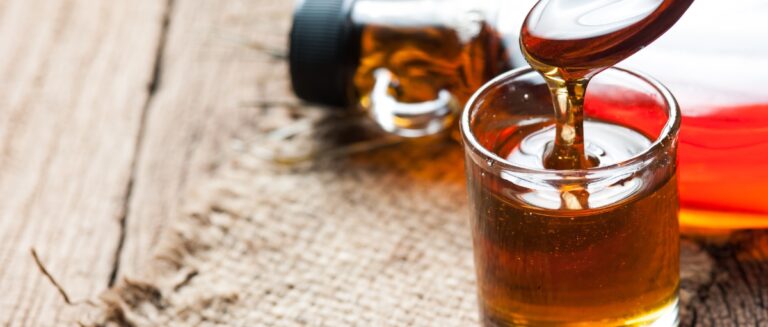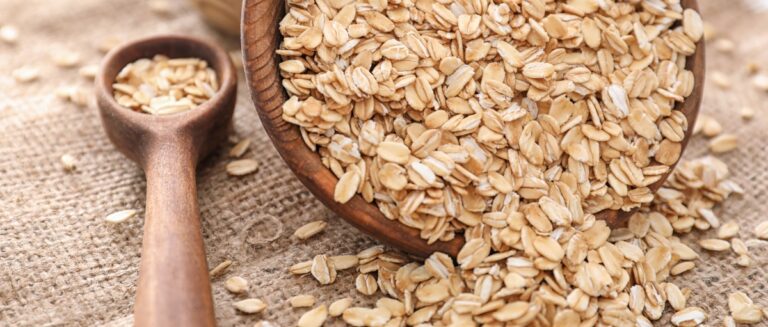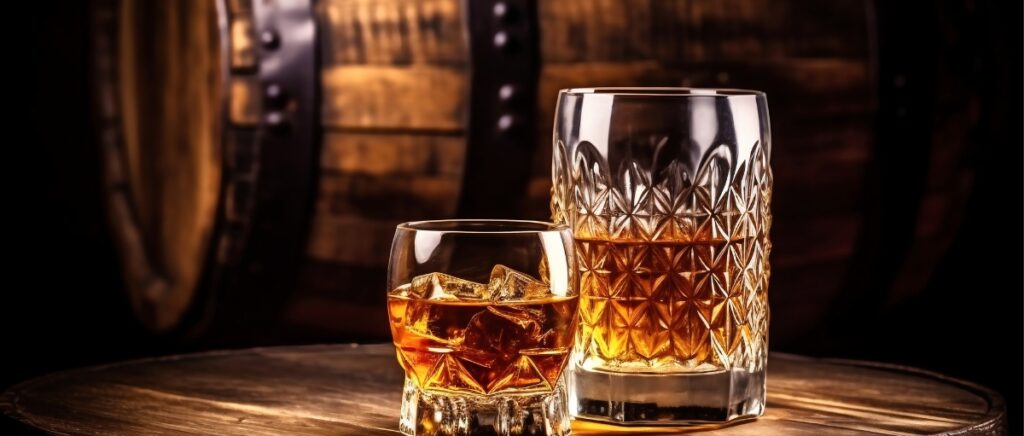Did you know that 43 bottles of Scotch whisky are exported from Scotland every second? Or has bourbon production increased by more than 495% since 1999? Whiskey and bourbon have captured the hearts and taste buds of people worldwide.
The classic whiskey vs. bourbon debate has confused even seasoned drinkers. While the two are often used interchangeably, they’re not the same. All bourbon is whiskey, but not all whiskey is bourbon. Confused? Don’t worry, you’re not alone.
Whether you’re a long-time whiskey enthusiast or a curious newcomer to brown spirits, this article will provide you with the knowledge and appreciation to confidently navigate the whiskey aisle at your local liquor store. You’ll learn what makes each spirit special and how to choose the right one for your taste preferences.
So sit back, pour yourself a glass of your favorite whiskey or bourbon, and embark on a journey through the fascinating world of these timeless spirits.
What is Whiskey?
The word “whiskey” comes from the Gaelic term “uisge beatha,” which translates to “water of life.” Whiskey is a broad category of grain-based spirits that are distilled and aged in wooden barrels. The type of grain used, the distillation process, and the aging method all contribute to the unique flavors and characteristics of different whiskeys.
Types of Whiskey
There are several types of whiskey, each with its own distinct qualities and production methods. Some of the most well-known types include:
- Scotch: Made in Scotland, Scotch whisky is known for its smoky, peaty flavor. It must be aged in oak barrels for at least three years.
- Irish Whiskey: Produced in Ireland, Irish whiskey is typically smooth and light in flavor. It is often triple-distilled and aged in wooden casks for at least three years.
- Japanese Whisky: Japanese whisky has gained popularity recently for its high quality and unique flavor profile. It is often modeled after Scotch whisky but with a distinctly Japanese twist.
- Canadian Whisky: Known for its light and smooth taste, it is often blended and aged for at least three years in wooden barrels.
- American Whiskey: American whiskey includes several sub-categories, such as bourbon, rye, and Tennessee whiskey. Each has its own set of legal requirements and production methods.
Production Process
The production of whiskey involves several key steps:
- Grains: Whiskey is made from fermented grain mash, which can include corn, rye, wheat, and barley. The type and proportion of grains used will vary depending on the specific type of whiskey being produced.
- Distillation: Once the grains have been fermented, the liquid is heated in a still to separate the alcohol from the water and other impurities. The resulting liquid, known as “new make” or “white dog,” is then placed in wooden barrels to age.
- Aging: The aging process is crucial to developing whiskey’s flavor and color. As the spirit interacts with the wooden barrel, it takes on notes of vanilla, caramel, and oak, while also absorbing some of the wood’s color. The length of aging will vary depending on the type of whiskey and the desired flavor profile.
Understanding the different types of whiskey and their production methods is key to appreciating the diverse flavors and characteristics of this beloved spirit.
What is Bourbon?
Bourbon whiskey is a type of American whiskey with its own legal requirements and production methods. For a whiskey to be classified as bourbon, it must meet the following criteria:
- Produced in the United States
- Made from a grain mixture (mash bill) that is at least 51% corn
- Distilled to no more than 160 proof (80% alcohol by volume)
- Aged in new, charred oak barrels
- Entered into the barrel at no more than 125 proof (62.5% alcohol by volume)
- Bottled at a minimum of 80 proof (40% alcohol by volume)
History and Origins
Bourbon has a rich history that is deeply intertwined with American culture and heritage. The name “bourbon” comes from Bourbon County, Kentucky, where the spirit was first produced in the late 18th century. However, bourbon can be made anywhere in the United States, not just in Kentucky.
The early distillers who helped establish straight bourbon as a distinct type of whiskey were mostly settlers from Scotland and Ireland who brought their distilling knowledge to the New World. They found that the native corn grew well on American soil and began using it as the primary grain in their whiskey mash bills.
The Bottled-in-Bond Act passed in 1897, established standards for the production and labeling of bourbon. This act helped ensure the quality and consistency of bourbon, and it remains an important part of the spirit’s identity today.
Production Process
The production of bourbon involves several key steps that set it apart from other types of whiskey:
- Mash Bill: Bourbon must be made from a grain mixture of at least 51% corn. The remaining grains can include rye, wheat, and malted barley. The high proportion of corn in the mash bill gives bourbon its distinctive sweet and smooth flavor profile.
- Sour Mash Technique: Many bourbon distillers use a sour mash technique, which involves adding a portion of the previous batch’s mash to the new batch. This helps maintain consistency in flavor and ensures the yeast strain remains healthy and active.
- Aging: Bourbon must be aged in new, charred oak barrels. The charring process caramelizes the wood’s sugars, giving charred bourbon its rich amber color and complex flavor profile. As the bourbon interacts with the barrel over time, it takes on notes of vanilla, caramel, and spice.
Combining the mash bill, sour mash technique, and aging process gives bourbon its unique character and distinguishes it from other types of whiskey.
Comparing Whiskey and Bourbon
While whiskey and bourbon share many similarities, several key differences set them apart. Understanding these differences can help you appreciate the unique characteristics of each spirit and make informed choices when selecting a whiskey or bourbon to enjoy.
Ingredients and Production
The primary difference between bourbon and whiskey is the ingredients and production methods. Whiskey can be made from a variety of grains, including corn, rye, wheat, and barley, and the proportions of these grains can vary widely depending on the type of whiskey being produced. Bourbon, on the other hand, must be made from a mash bill that is at least 51% corn, with the remaining grains typically being rye, wheat, or malted barley.
Another key difference is the aging process. While both whiskey and bourbon must be aged in wooden barrels, bourbon must be aged in new charred oak barrels. This gives bourbon its distinctive vanilla, caramel, and toasted oak flavors, as well as its rich amber color. Whiskey, on the other hand, can be aged in a variety of barrel types, including used barrels that previously held other spirits like wine or port.
Flavor Profiles
The differences in ingredients and production methods result in distinct flavor profiles for whiskey and bourbon. Whiskey can have a wide range of flavors depending on the type and origin, ranging from the smoky, peaty notes of Scotch to the light, fruity flavors of Irish whiskey. With its high proportion of corn and aging in new, charred oak barrels, Bourbon tends to have a sweeter, smoother flavor profile with notes of vanilla, caramel, and spice.
Popular Brands
Some popular whiskey brands include:
- Johnnie Walker (Scotch)
- Jameson (Irish whiskey)
- Crown Royal (Canadian whisky)
Well-known bourbon brands include:
Enjoying Whiskey and Bourbon
Whether you prefer whiskey or bourbon, there are many ways to enjoy these spirits. Here are a few popular options:
Neat, on the Rocks, or with Water
Drinking whiskey or bourbon neat (without any additions) allows you to appreciate the complex flavors and aromas of the spirit fully. Some people prefer to add a few drops of water, which can help to open up the flavors and make the whiskey or bourbon more approachable. Others enjoy their whiskey or bourbon on the rocks (over ice), which can help to mellow out the alcohol and make the drink more refreshing.
Classic Cocktails
Whiskey and bourbon are also popular ingredients in many classic cocktails. Here are a few recipes to try:
Whiskey Cocktails:
- Old Fashioned: 2 oz whiskey, 1 sugar cube, 2 dashes Angostura bitters, orange peel
- Manhattan: 2 oz whiskey, 1 oz sweet vermouth, 2 dashes Angostura bitters, maraschino cherry
- Whiskey Sour: 2 oz whiskey, 3/4 oz lemon juice, 3/4 oz simple syrup, optional egg white
Bourbon Cocktails:
- Mint Julep: 2 oz bourbon, 1/2 oz simple syrup, fresh mint leaves
- Bourbon Sour: 2 oz bourbon, 3/4 oz lemon juice, 3/4 oz simple syrup, optional egg white
- Boulevardier: 1 1/2 oz bourbon, 1 oz Campari, 1 oz sweet vermouth
Raise a Glass To Whiskey and Bourbon
Whiskey and bourbon are two beloved spirits that have captured the hearts and taste buds of people worldwide. While they share many similarities, the differences in their ingredients, production methods, and flavor profiles make each one unique and worthy of exploration.
Whether you’re a long-time whiskey enthusiast or a bourbon beginner, there’s a wide range of options to suit every taste preference. The possibilities for enjoying whiskey and bourbon are endless, from sipping neat to mixing in classic cocktails.
So, the next time you want to unwind with a drink, consider reaching for a bottle of your favorite whiskey or bourbon. Savor the complex flavors and aromas and reflect on the rich history and craftsmanship that went into each sip.
Sources
Scotch Whisky Association. (2024). Facts and figures on the whisky industry. Retrieved from https://www.scotch-whisky.org.uk/industry-insights/facts-figures/
Spectrum News 1. (2023). Kentucky bourbon boom continues to shape the industry. Retrieved from https://spectrumnews1.com/ky/louisville/news/2023/09/01/kentucky-bourbon-boom
Edinburgh Whisky Academy. (2024). Whisky words: Uisge Beatha – The water of life. Retrieved from https://www.edinburghwhiskyacademy.com/blogs/definition/whisky-words-uisge-beatha
New Riff Distilling. (2024). What are the different whiskey and bourbon grains?. Retrieved from https://www.newriffdistilling.com/what-are-the-different-whiskey-and-bourbon-gains/
New Riff Distilling. (2024). What makes bourbon, bourbon?. Retrieved from https://www.newriffdistilling.com/what-makes-bourbon-bourbon/
Distiller Magazine. (2024). What the Bottled-in-Bond Act of 1897 means today. Retrieved from https://distilling.com/distillermagazine/what-the-bottled-in-bond-act-of-1897-means-today/
Liquor Loot. (2024). The science of aging whisky: Understanding the barrels. Retrieved from https://liquorloot.com/blogs/articles-blog-post/the-science-of-aging-whisky-understanding-the-barrels











